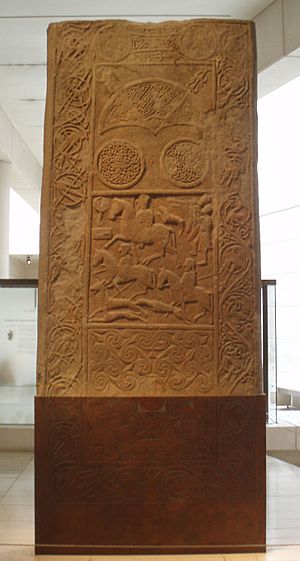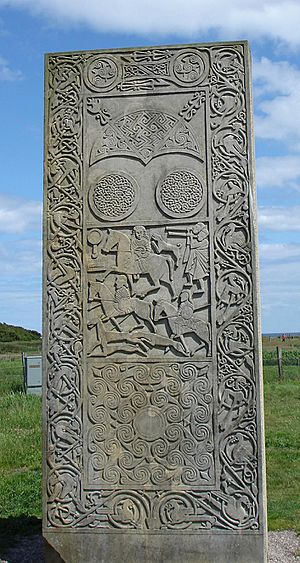Hilton of Cadboll Stone facts for kids
The Hilton of Cadboll Stone is a very old and beautiful stone carving made by the Picts. The Picts were an ancient people who lived in Scotland. This special stone was put up in Easter Ross, Scotland, around the year 800 AD. It was probably made for a nearby monastery in Portmahomack. The stone stood in a natural open area, close to the sea. Later, a chapel and a village grew up nearby.

Contents
The Stone's Journey Through Time
The Hilton of Cadboll Stone has had quite an adventure! In 1674, a big storm knocked the stone over. The top three-quarters broke off. Someone then chipped away the cross design on the front. They tried to turn it into a memorial for a person named Alexander Duff and his three wives. However, it was never actually used as a memorial.
Later, in the 1860s, the top part of the stone was moved to a garden at Invergordon Castle. In 1921, it was going to be given to the British Museum. But Scottish historians worked hard to keep it in Scotland. So, it was instead given to the National Museum of Scotland, where it is today.
Finding the Missing Piece
The bottom quarter of the stone stayed in its original spot at Hilton of Cadboll. In 1998, people digging near the old chapel found small pieces of carved stone. They thought these might be from the missing cross part of the Hilton of Cadboll Stone.
Then, in 2001, more digging happened. This time, they found many more carved pieces. Most excitingly, they found the missing lower part of the stone! This bottom piece is now on display in Balintore. It looks almost new!
A copy of the bottom part was added to the main stone in Edinburgh. However, this copy only shows the back of the stone, not the special stepped base of the cross on the front.
A Modern Copy
In the 1990s, some people wanted the original stone to be returned to its first home. When that didn't happen, a local artist named Barry Grove made a full-size copy of the stone. This copy was put up near the original spot.
At first, the hunting scene on the copy was placed on the west side. But after the original bottom part was found, it showed that the hunting scene was actually on the east side. The west side had the cross with a stepped base. This means that people facing the cross would be looking east, just like in a church. So, the side with the cross is called the front, and the side with the hunting scene is called the back.
What the Stone Shows
The Hilton of Cadboll Stone is covered in amazing carvings that tell stories and show symbols.
The Front of the Stone
On the bottom quarter of the front of the stone, you can see the stepped base of a cross. This cross likely represented a Calvary cross, which is a symbol of Jesus's crucifixion. From the small pieces found, experts believe the cross was surrounded by figures. These figures might have shown ideas about death, judgment, heaven, and hell.
The Back of the Stone
The back of the stone has a beautiful border of vine-scrolls. This design often represents the Eucharist, a Christian ceremony. At the very top, there are two Pictish symbols: a double disc and a Z-rod. We don't know exactly what these symbols mean, but they appear often on Pictish stones with Christian symbols. This suggests they also have a Christian meaning.
Below these symbols are three square panels:
- Top Panel: This panel shows a crescent and V-rod symbol, another Pictish design. Below it are two round discs with knotwork patterns. Even though we don't know the exact meaning of these symbols, their important position suggests they are also Christian symbols.
- Middle Panel: This panel shows a hunting scene. A very important person is riding a horse, facing forward. For a long time, people thought this was a picture of a rich woman, because there's a mirror symbol nearby. But now, many experts believe it shows Christ or the Virgin Mary. The scene might be based on an old Roman ceremony called Adventus. The object in front of the figure might be a penannular brooch or even a cross on a shield. At the bottom, two dogs are chasing a deer. This reminds people of Psalm 42 from the Bible, where a deer searching for water is like a soul searching for salvation.
- Bottom Panel: This panel was broken when the stone fell. It has a swirling design with triskeles (three-legged spirals). This design is so famous that the nearby Glenmorangie whisky company uses it as their logo! When the bottom part of the stone was found, experts could put together more pieces of this panel. They discovered that in the middle was a cross, similar to the one on the Edderton cross-slab. The swirling design comes out from four points around this cross. This panel is now thought to represent the four rivers of paradise flowing from the cross.
Some experts, like Martin Goldberg, think the Hilton of Cadboll Stone played a special role in the Easter Vigil. This was a time when new people joined the Christian community through Baptism. The hunting scene on the back, with the deer, might have reminded people of Psalm 42, which was sung during this ceremony. The stone was also near a stream, which would have made baptisms by immersion possible.
Digging Up the Past: Archaeology
Between 1998 and 2003, archaeologists (people who study old things) did a lot of digging around the Hilton of Cadboll Chapel.
In 1998, they found about 40 pieces of carved stone. They believed these pieces were from the missing cross face of the Hilton of Cadboll Stone.
Then, in 2001, more digging happened. They found 740 more carved pieces and 122 pieces that might have been carved. Most importantly, they found the missing lower part of the cross-slab! It was left in the ground at first.
Later in 2001, the lower part of the stone was carefully removed, along with thousands more carved pieces. The way these pieces were spread out suggests that someone tried to dig up the whole stone a long time ago. When that failed, they started damaging the cross while it was still standing. When the stone fell in a storm, it broke and landed with the cross-face facing up. People continued to damage it even after it was on the ground.
By studying these fragments, experts were able to put together parts of the lost cross-face. This helped Isabel Henderson figure out what the carvings on the cross-face meant. This information was then used by Barry Grove when he carved the front of the modern copy of the stone in 2003-2005.
After some discussion, it was decided that the lower part of the original stone belonged to the National Museum of Scotland. However, it was agreed that it should be shown in the Hilton of Cadboll village hall, rather than joining the top part in Edinburgh.
During the excavations, Professor Sian Jones from the University of Manchester also studied how important old sculptures like this are to local communities. She looked at how the Hilton of Cadboll monument was broken and moved over time, and how it helps people understand their history and local identity today.
Images for kids



